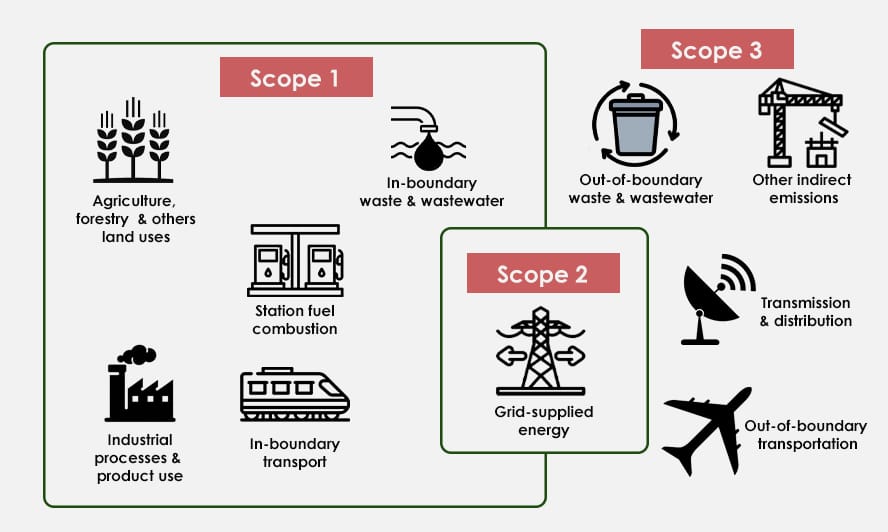Your Partner in Emissions Accountability

By: Kinkini Chakraborty, Shubham Pal, Anurag Bajpai and Shweta Shukla
The Greenhouse Gas Protocol is a globally acknowledged platform for measuring & managing greenhouse gas emissions. Established in 1990 as a 20-year partnership between the World Resources Institute (WRI) & World Business Council for Sustainable Development (WBCSD), the GHG Protocol works with governments, industry associations, NGOs, businesses and other organizations.
Nations and enterprises committed to the Paris Agreement are committed to reducing their greenhouse gas emissions. Hence, they are required to track, disclose, and mitigate their emissions by adhering to the guidelines laid down in the GHG Protocol. GHG Protocol has played a pivotal role in decarbonizing industries & cities by providing a unified framework & standards for emissions management.
Who does the GHG Protocol apply to?
- Business: Both public & private enterprises across all sectors are encouraged to use the GHG Protocol to track & report their emissions.
- Governments: Government Entities at state and national levels can use the GHG Protocol to track and report their emissions.
- Cities & Municipalities: City administrators & municipalities can benefit from GHG Protocol by disclosing
- Investors: Investors & financial institutions can use GHG reporting to assess the environmental performance & risk exposure of the companies they are investing in.
- Academic & Research Institutions: Universities & Research Institutes can use the GHG Protocol to study & analyze emissions data, evaluate policy effectiveness & understand the broader issues of climate change.
- Consulting firms: Consulting firms can make use of GHG reporting to provide clients with expertise in measuring & managing emissions.
- Industry Associations: Trade organizations & Industry Associations can adapt to the GHG Protocol to set standardized emission policies across various sectors.

GHG Protocol considers six greenhouse gases to calculate a company’s emissions:
Carbon Dioxide (CO2), Nitrous Oxide (NO), Methane (CH4), Sulphur Hexafluoride (SF6)
The GHG Protocol standard then classifies these emissions into three categories: Scope 1, Scope 2, and Scope 3.
Scope 1 & 2 are mandatory while Scope 3 is voluntary & toughest to measure.
- Scope 1 emissions: These are direct emissions from controlled & company-owned resources that result from activities executed by companies like fossil fuel power generating companies, and the fleet of the company.
- Scope 2 emissions: These are indirect emissions from the generation of purchased energy from a utility provider.
- Scope 3 emissions: These are indirect emissions that result from upstream & downstream activities of a reporting company’s value supply chain. Scope 3 emissions are divided into 15 categories including business travel, waste disposal & purchased goods & services.
Reducing Scope 1 emissions:
- Reduce your energy consumption: Electrical appliances should be judiciously used in offices & homes. HVAC systems should be used according to their need & purposes.
- Increase your energy efficiency: Replacing conventional lighting with LED lighting, using building automation, energy-efficient HVAC systems. Using BEE-rated appliances, adding more insulation to buildings to prevent heat from escaping.
- Switch from fossil fuels to renewable energy sources: Replacing coal boilers with natural gas, solar, wind, geothermal, etc. can reduce scope 1 emissions up to a significant level.
- Purchase carbon offsets: A carbon offset is a credit that a person or organization can buy to decrease its carbon footprint. When the number of carbon offset credits obtained is equal to an individual or organization’s carbon footprint, that organization is said to be carbon neutral.
Reducing Scope 2 Emissions:
I. Enter into offsite power purchase agreement: Offsite PPAs are renewable power/ energy contracts between a project developer & a company where renewable energy installation is not sited at the location of the company's electrical usage. PPAs can deliver energy physically to a company through the grid.
Onsite vs Offsite
- Onsite power generation is better in terms of ROI than Offsite power generation.
- Offsite is the fastest way for companies to meet their corporate sustainability goals.
- Companies can procure offsite renewable energy via many avenues including physical PPAs & virtual PPAs.
II. Renewable Energy Certificate: The REC mechanism is a market-based instrument to promote renewable energy & facilitate compliance with renewable purchase obligations. It is aimed at addressing the mismatch between the availability of RE resources in the state & the requirement of the obligated entities to meet the renewable purchase obligations.
One REC represents 1 MWh of energy generated from renewable sources.
III. Utilize green tariff: Green tariffs are programs in the regulated electricity market offered by utilities that allow large commercial & industrial customers to buy bundled renewable energy from a specific project through a special utility tariff. Green tariffs increase a company's ability to access green power. In addition, they provide price predictability & potential cost savings on electricity & the ability to point to a specific, often local, renewable energy project as the source of your electricity.
Reducing Scope 3 Emissions:
- Collecting data on scope 3 emissions: This can't be managed but measured.
- Provide aid to suppliers in their sustainability journey.
- Encourage employees to utilize sustainable transportation options.

How does the built environment engage in scope emissions?
Scope 1:
- Burning of onsite combustion fuel like coal, and wood for cooking & heating purposes.
- Using company-owned vehicles & machinery
Scope 2:
- Purchased electricity, steam, heating, and cooling.
Scope 3: (Other Indirect Emissions):
- Embodied carbon in construction materials.
- Transportation of construction materials and waste.
- Tenant energy use and waste generation.
- Water consumption.
- Employee commuting and business travel.
- Supply chain activities.
How to Reduce Scope Emissions in a Built Environment?
- Transition to electric or renewable energy-powered heating and cooling systems.
- Implement energy-efficient building designs and technologies.
- Use electric vehicles or low-emission alternatives for company fleets.
- Regular maintenance to ensure optimal operation of equipment and systems.
- Purchase or generate renewable energy (e.g., solar panels, wind turbines).
- Implement energy-saving practices and policies for tenants and occupants.
- Use energy-efficient appliances and lighting.
- Use low-carbon and sustainable building materials.
- Optimize construction processes to reduce waste and emissions.
- Engage with suppliers to encourage sustainable practices.
- Implement green building certifications (e.g., LEED, BREEAM).
- Promote public transportation, carpooling, and cycling for employees.
- Encourage tenants to adopt energy-efficient practices and appliances.
- Develop waste reduction and recycling programs.
How does GRESB address Scope Emissions 1,2,3?
To calculate these emissions, within the performance indicators aspect of GRESB Real Estate Assessment, It uses a methodology that encompasses the following:
- Estimates missing energy consumption to GHG Emissions using the GRESB Estimation model
- Converts energy consumption to GHG emissions using emission factors
- Calculates asset level GHG intensities by dividing emissions by floor area
- Aggregates asset level intensities to portfolio level by taking the floor area-weighted average
This allows GRESB to provide a completely, globally applicable understanding of Scope 1 & 2 GHG intensity using the most granular data available.
GRESB introduced mandatory reporting of Scope 3 emissions in 2018 following pressure from investors to capture a more comprehensive view of emissions portfolios. The GRESB Assessment focuses on tenant emissions as a key Scope 3 category for the real estate sector. However, GRESB recognizes that companies must now begin to consider the full range of major Scope 3 emissions, including embodied carbon from construction and retrofits.
Organizational and Operational Boundaries
To accurately report emissions, GRESB requires companies to define their organizational and operational boundaries. This includes determining whether to use the equity share or control approach for organizational boundaries, and delineating direct emissions (Scope 1), indirect emissions from purchased energy (Scope 2), and other indirect emissions (Scope 3).
In summary, GRESB has a robust methodology for measuring and reporting Scope 1, 2, and 3 emissions, while pushing the real estate sector to expand its consideration of Scope 3 emissions and set ambitious targets to reduce its overall carbon footprint.
How GreenTree can offer your business to reduce your carbon footprint?
We at GreenTree Global have 15 years of experience in the field of Carbon Efficiency, ESG & Climate Change. We have executed over 900+ projects around the world having expertise in carbon efficiency projects - from concept to commissioning & operation Headquartered in Delhi NCR & have offices in Mumbai, Dehradun, Guwahati, Lucknow & Bangladesh.
We are the official partner of (Global Real Estate Sustainability Benchmark) GRESB assisting clients with the ESG mandatory disclosures thereby improving their performance towards their sustainability goals. GreenTree Global further provides consultancy services to provide ESG certification.





